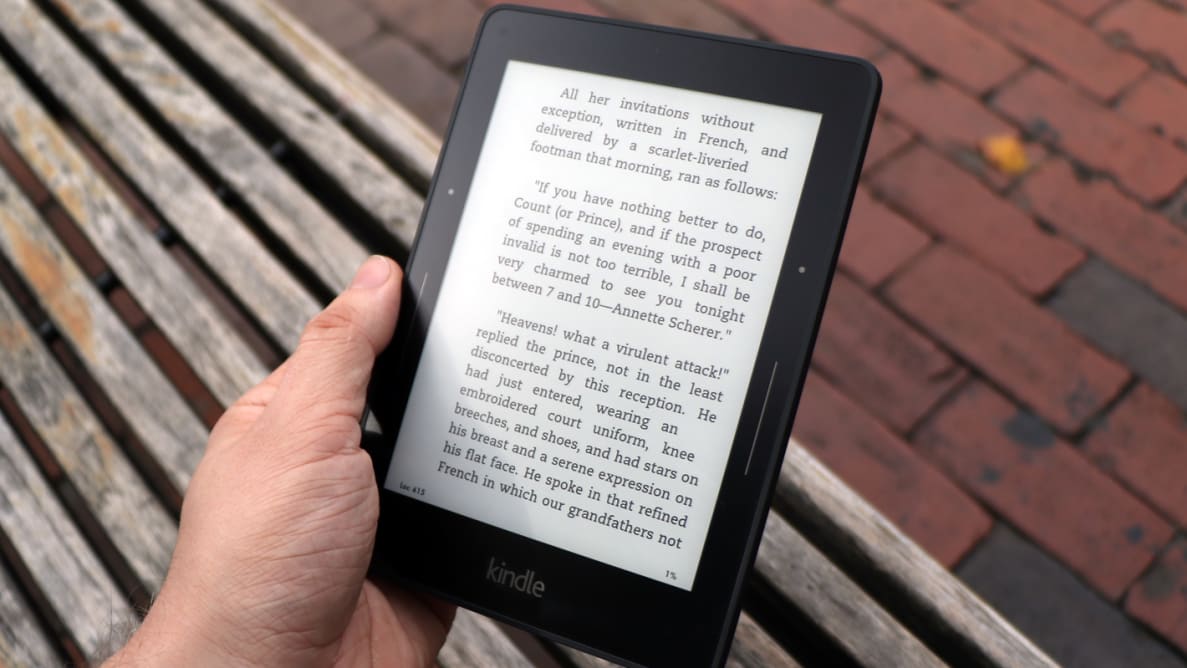Introduction
Despite this, Amazon has continued to improve upon its line of eReaders. Its latest flagship eReader, the Kindle Voyage (MSRP $199), focuses on the first two elements of the recipe, sacrificing on the third. The result of this grand experiment? The best eReader we've ever seen.
Of course, this is also the most expensive eReader in Amazon's lineup, available for a healthy $80 premium over Amazon's already superb Kindle Paperwhite reader. Is the extra money worth investing? We took the Voyage on a journey through our labs to find out.
Design
The same, but better.
If there's an archetype of an eReader, the Kindle most closely fits it. The Voyage, in particular, does very little to stray from that mold: its flat front, matte screen casing, and side-oriented page turn buttons feel more familiar than the pages of an actual book. Though everything's a little slicker this time around, most of the design features found on the Voyage are found on last year's Kindle Paperwhite.
{{ photo_gallery "tour" }}
The eReader still charges through a microUSB cable, the aspect ratio and software haven't changed much, and the device is imperceptibly lighter than its predecessor. The chassis of the Voyage is needlessly changed to look cooler than it actually is. That's really not a gripe that should give anyone pause, but there are idiosyncrasies introduced by it. For example, the backing material is a little more slippery, the power button has moved from the side of the device to the back, and the screen is slightly more reflective in the presence of diffuse light.
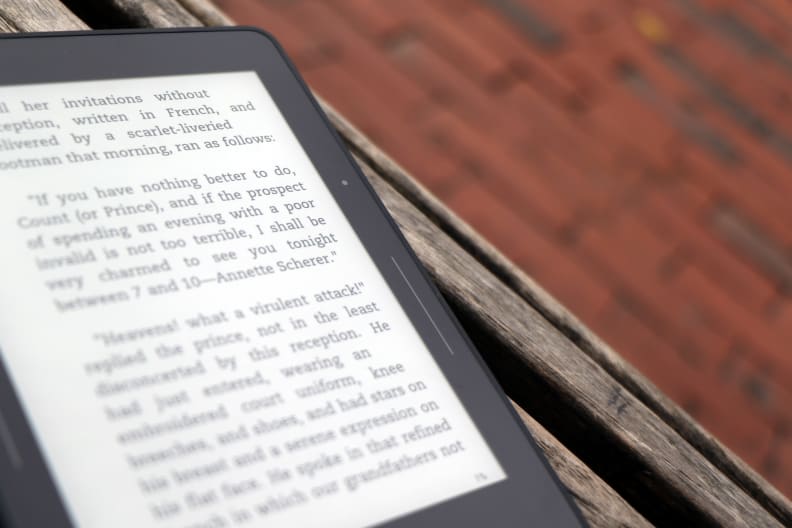
Page turn buttons make their return on the sides of the bezel.
So why the extra $80 at checkout? Much of that has to do with iterative upgrades that make the eReader experience more pleasent. First off is the screen: though the Paperwhite's screen is technically already print-quality, the Voyage takes it a step further and brings the pixel density to a Retina-level 300 DPI.
That's not as big of a deal as people think, however; magazines are generally 200 DPI. So what else is crammed in there to make life easier? An ambient light sensor, and bezel-oriented page controls to the left and right of the screen. Both are welcome additions, and the page controls in particular are sorely missed on lower-end models. Additionally, if you spring for a case for the Voyage, smartcovers can toggle the device on whenever you flip the cover back.
{{ photo_gallery "design" }}
Lighting & Screen
Sometimes the intelligent choice means not being bright
Dedicated eReaders typically use an "e-ink" screen. This screen by itself merely reflects ambient light, which is why it's easy to read out in the sun and doesn't fatigue your eyes as much. If you want to be a bookworm in bed, however, you need an eReader that supplies its own light when need be. Last years Kindle Paperwhite could do this, but it lacked the ability to tell when your surroundings only required a little light to remain visible. The result was that you had to adjust the brightness manually to save battery and make things easier on the eyes.
The Kindle Voyage fixes this problem with the inclusion of an ambient light sensor that will judge just how bright your screen needs to be for your current conditions, and adjust to meet them. In the long haul, that saves battery life—though eReaders typically don't run out of juice all that quickly anyways.
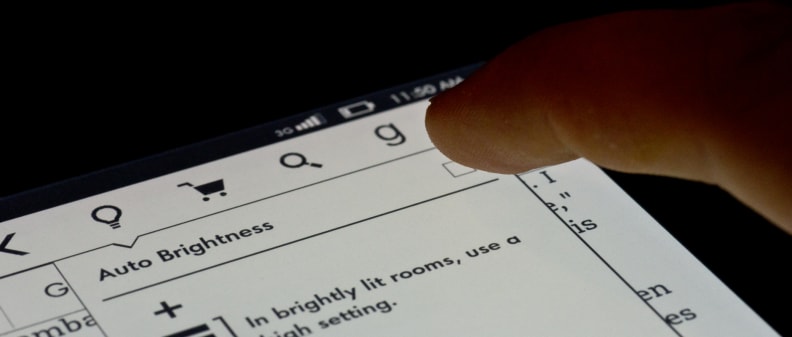
An automatic light adjusts to any brightness condition.
The automatic adjustment handles things generally well. The only problem we have here is that when manually adjusting brightness the menu seems to suggest that you should crank the lighting in brighter environments. That's true of traditional tablets, but not those with e-ink screens. In direct sunlight, this practice is just wasteful; you don't need any additional lighting on the beach or by the pool. Though battery life isn't typically a sore spot for eReaders, maximizing its efficacy is never a bad idea.
The other major addition to the Voyage is a new glass screen. It's supposed to be micro-etched for improved reflectivity over the Paperwhite. In our tests we found that it did worse with diffuse lighting (which isn't usually a big deal for reflectivity) but did handle specular lighting (such as direct sunlight) better than the matte screen on the Paperwhite. Either way, it should make for a far superior beach buddy than any traditional smartphone or tablet—no squinting required.
In Use
Letting the days go by, let the updates hold me down
If you've ever used a Kindle before, you know that the experience is refreshingly basic. Despite some experimental web browsing features, the device itself doesn't really do much to get in between you and several hours of reading. It's still a smart device, but it's one that encourages you to spend your time wisely.
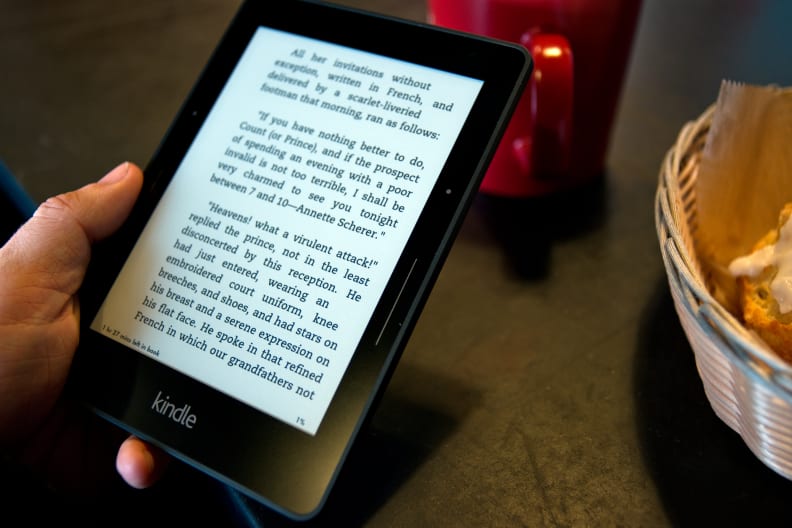
The Kindle Voyage is at home in any setting.
Though the feature is now years-old, Amazon continues to load up its eReaders with X-Ray: a really cool assistant program. The Voyage's capacitive touchscreen allows you to highlight words, passages, or characters, and really dig into as much information as you can handle. Nicknames throwing you for a loop in Dostoevsky's Crime and Punishment? X-ray can help with that too. You can also look up word definitions, tweet your favorite passages, or bookmark your favorite segments for later.
You might not find yourself using it everyday, but it's especially great if you're reading non-fiction or a complex novel with lots of characters to keep track of (read: Game of Thrones. Seriously. Read it!). It definitely makes reading archaic texts much easier, and if you're learning a new language this is a great way to immerse yourself, with an adaptive cheat sheet at your disposal. The internet and books are a match made in heaven—and the more you use it, the faster you'll scrape every possible bit of information from your favorite texts and stories.
The one part of the experience that still isn't perfect, it's the laggy display. Page turns are sluggish, and if you're used to the instant gratification of a smartphone you'll have to adapt. That's always been an issue with displays with this technology, so unless you're reading 6 pages per second you should be fine. And to be honest, it's still generally faster than flipping a physical page. Some users have noted image retention issues, but in our experience these "ghosting" issues are a bit overblown. This is easily the best eInk display in an eReader to date, and it's hardly like you're using a Voyage to edit photos.

Internet features are an old book's best friend.
Battery life varies wildly based on how much you use the lighting on the device, but we weren't able to exhaust the battery by any appreciable amount within a 24 hour period with the lighting disabled. Because eReaders use a display that only needs power when the image changes, short bursts of current are all that's needed to operate the screen—meaning this is a device that sips power slowly. If you turn the front light on, you can expect your battery life to dip, but you can conceivably take the Voyage on a weeks-long vacation and not think about charging it until you get back.
Conclusion
Cream of the crop, if you're willing to spend the cheddar
Despite their stranglehold on the eReader market, Amazon isn't resting on its laurels. Instead, it's drastically enhancing some areas of the eReader experience to satisfy buyers who just want the best of the best. It's not an earth-shattering update to the Paperwhite, but it's a better device without question.
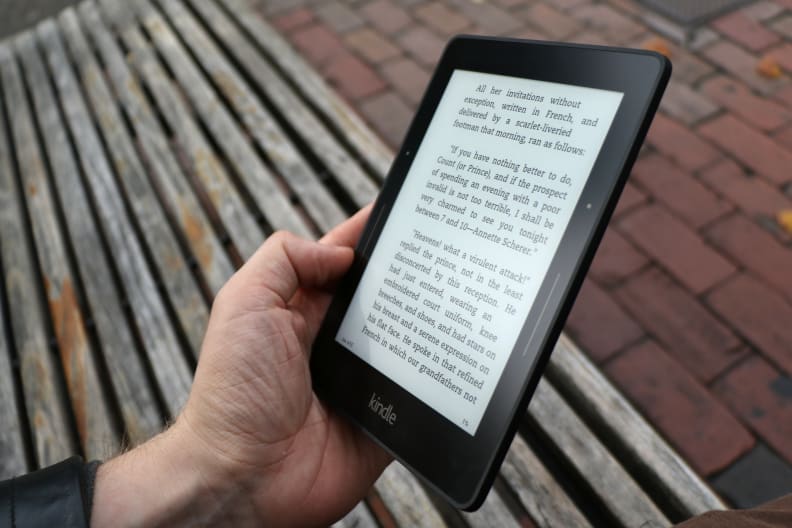
This eReader is slightly more reflective than the other members of the Kindle line.
What is a question is whether most people should shell out the extra $80 over just getting a Paperwhite. To that we'd answer that the Kindle Voyage is about as close to perfect as it gets for an eReader. Its screen is beautiful, the ambient light sensor makes the most of the front lighting, and the return of the bezel controls are a great perk for those who want to keep fingerprints on their screen to a minimum. With X-Ray, the Voyage is every bit as versatile as the Paperwhite, and you'll never feel lost again.
But the Kindle Paperwhite could've been described in the same glowing terms. And with the Voyage starting at $199 and ramping up from there based on the configuration you want, this will set you back a pretty penny for what truthfully amounts to a minor upgrade. If you're okay with losing the bezel controls and the ambient light sensor, the Kindle Paperwhite will give you almost the same experience for $80 less. It even has all the internet-ready features found on the Voyage, with the ad-free, 3G-sporting Paperwhite costing just $10 more than the Wifi-only Voyage base model.
That's a tempting deal, but price aside the Voyage is simply the best eReader you can buy. It's better than even the Paperwhite in appreciable ways, enhancing what was already a superb experience. It's not the cheapest, but on voyages short or long, it's a travel companion that you'll never want to be without.
Meet the tester
A seasoned writer and professional photographer, Chris reviews cameras, headphones, smartphones, laptops, and lenses. Educated in Political Science and Linguistics, Chris can often be found building a robot army, snowboarding, or getting ink.
Checking our work.
Our team is here for one purpose: to help you buy the best stuff and love what you own. Our writers, editors, and lab technicians obsess over the products we cover to make sure you're confident and satisfied. Have a different opinion about something we recommend? Email us and we'll compare notes.
Shoot us an email
